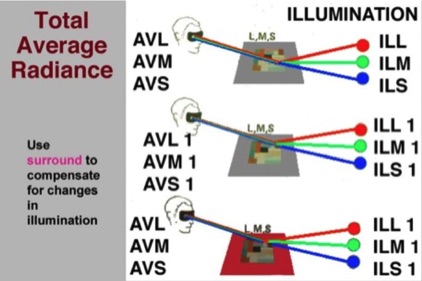Measurements of color changes due to
Chromatic Adaptation
Stimulus modifications equal to Chromatic Adaptation
fails to change color appearances.
Color Constancy experiments observe the very small changes in appearance with changes in illumination. Chromatic Adaptation theories propose that human vision auto-compensates for changes in illumination. These experiments directly measure the magnitude of appearance changes cause by the magnitude of illumination changes used in constancy experiments. No changes greater than experimental uncertainty were observed. There is no evidence to support a Chromatic Adaptation mechanism to explain Color Constancy.
J.J. McCann, "Local-Global Mechanisms for Color Constancy" Proc. AIC, Florence, in Die Farbe, 15, 275-283, 1987. .
J.J. McCann, "The role of nonlinear operations in modeling human color sensations”, in Human Vision, Visual Processing and Digital Display, SPIE Proc., Bellingham, WA, 1077, 355-363, 1989.
J.J. McCann, “ Magnitude of Color Shifts from Average-Quanta Catch Adaptations”, in Proc. 10th IS&T/SID Color Imaging Conference, Scottsdale, Arizona, 215-220, 1997.
J. J. McCann, “Color Mondrian Experiments Without Adaptation”,
in Proceedings AIC, Kyoto, 159-162, 1997.
